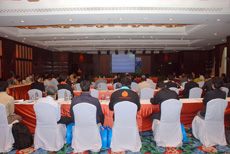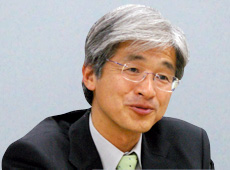
SAFE workshop held in Thailand in May 2009. (Courtesy of GISTDA/JAXA)
Q. What new activities will APRSAF undertake?
So far, we have been promoting the Sentinel Asia project for disaster monitoring, and SAFE, a new environment monitoring project Japan proposed at last year's APRSAF. SAFE stands for Space Application for Environment, which effectively means environmental monitoring through space technology. Its goal is to identify local problems with water, forest development and land utilization. It also aims to investigate how data from satellites or space technology can be used to solve these problems, and to encourage cooperation among related organizations. As a first step, we developed a prototype system last year for the Vietnamese government to use satellite data for water resource management and land utilization monitoring. This year, we plan to expand our activities to Laos and Cambodia, and would like to make this a case study that will allow us to expand the project and contribute to environmental protection in other regions, and ultimately across all of Asia.
Europe also has an environmental monitoring program, which covers Europe and Africa. Global Monitoring for Environment and Security (GMES) deals with environmental problems, but also security issues such as refugee support and disaster monitoring. GMES has also established an international consortium to respond to local issues and to develop a utilization system. I think we also have to develop a similar utilization system in Asia. In order to do this, we need to make Sentinel Asia a success in disaster monitoring, then promote the SAFE project for environmental monitoring and the STAR Program to support the development of human capital in Asian space programs.
One goal is the formation of an integrated satellite utilization system using not only Earth observation satellites but also others such as the Wideband Internetworking Engineering Test and Demonstration Satellite KIZUNA (WINDS) and the Quasi-Zenith Satellite System (QZSS), which provides positioning information. This kind of satellite system could have many applications. There are many regions in Asia where the Internet environment has not yet been established, but these places need a network to provide prompt information in order to reduce damage from disasters. The Global Positioning System can be used not only in disaster monitoring, but also in agriculture, fisheries, transportation and others. So our activities could extend to cooperation in these fields.
So far, we have been promoting the Sentinel Asia project for disaster monitoring, and SAFE, a new environment monitoring project Japan proposed at last year's APRSAF. SAFE stands for Space Application for Environment, which effectively means environmental monitoring through space technology. Its goal is to identify local problems with water, forest development and land utilization. It also aims to investigate how data from satellites or space technology can be used to solve these problems, and to encourage cooperation among related organizations. As a first step, we developed a prototype system last year for the Vietnamese government to use satellite data for water resource management and land utilization monitoring. This year, we plan to expand our activities to Laos and Cambodia, and would like to make this a case study that will allow us to expand the project and contribute to environmental protection in other regions, and ultimately across all of Asia.
Europe also has an environmental monitoring program, which covers Europe and Africa. Global Monitoring for Environment and Security (GMES) deals with environmental problems, but also security issues such as refugee support and disaster monitoring. GMES has also established an international consortium to respond to local issues and to develop a utilization system. I think we also have to develop a similar utilization system in Asia. In order to do this, we need to make Sentinel Asia a success in disaster monitoring, then promote the SAFE project for environmental monitoring and the STAR Program to support the development of human capital in Asian space programs.
One goal is the formation of an integrated satellite utilization system using not only Earth observation satellites but also others such as the Wideband Internetworking Engineering Test and Demonstration Satellite KIZUNA (WINDS) and the Quasi-Zenith Satellite System (QZSS), which provides positioning information. This kind of satellite system could have many applications. There are many regions in Asia where the Internet environment has not yet been established, but these places need a network to provide prompt information in order to reduce damage from disasters. The Global Positioning System can be used not only in disaster monitoring, but also in agriculture, fisheries, transportation and others. So our activities could extend to cooperation in these fields.

Q. Can you tell us about JAXA's future hopes for expansion in Asia?
So far, Japan has been actively promoting space utilization across Asia. In the future, we would also like to demonstrate leadership in space utilization among Western nations as well. To do this, we need to construct a system of regional cooperation in space utilization. We have to think more specifically about how we can manage to resolve regional issues and construct an integrated system using our Asian neighbours' high potential.
Currently, APRSAF has four working groups: Earth observation, communications, space environment utilization, and space education. Each group works under joint Asian leadership. We would like to link these activities so that they interact with others. In other fields, for example space-science projects such as planetary exploration, cooperation among Asian countries has already started. JAXA as a whole would like to find ways contribute to Asian society and to continue to promote cooperation with Asian countries by supporting their efforts. In the end, I hope space utilization in Asia will become an example of successful regional cooperation throughout the world.
So far, Japan has been actively promoting space utilization across Asia. In the future, we would also like to demonstrate leadership in space utilization among Western nations as well. To do this, we need to construct a system of regional cooperation in space utilization. We have to think more specifically about how we can manage to resolve regional issues and construct an integrated system using our Asian neighbours' high potential.
Currently, APRSAF has four working groups: Earth observation, communications, space environment utilization, and space education. Each group works under joint Asian leadership. We would like to link these activities so that they interact with others. In other fields, for example space-science projects such as planetary exploration, cooperation among Asian countries has already started. JAXA as a whole would like to find ways contribute to Asian society and to continue to promote cooperation with Asian countries by supporting their efforts. In the end, I hope space utilization in Asia will become an example of successful regional cooperation throughout the world.
Chu Ishida
Director, Space Cooperation Office for the Asia Pacific Region, Space Applications Mission Directorate
After working at theEarth Observation Center from 1978, Mr. Ishida was posted to the Washington, D.C. Office. He then worked while working for JAXA's Earth observation satellite projects such as JERS-1, ADEOS and ADEOS-II, while serving as secretariat for the Committee on Earth Observation Satellites (CEOS). He also worked for the Frontier Research System for Global Change (FRSGC), and the Earth Observation Research Center. In 2006, Mr. Ishida started work at the Satellite Application and Promotion Center. He was posted to his current position in 2008.
Linking Asia to Tackle Disaster and Environmental Issues
Participating in the Human Resources Project STAR
Observing Earth's Environment from Space: Expectations for the SAFE Project
Participating in the Human Resources Project STAR
Observing Earth's Environment from Space: Expectations for the SAFE Project